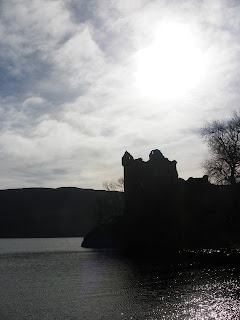Fort
Augustus Abbey sits in all its
splendour at the very edge of Loch Ness.
I have stayed there. Its archaic
walls tall and foreboding, a walk along its cloisters revealing a large
chess set in the sheltered courtyard. As you walk down a little gravel path that
winds between trees, you suddenly emerge beside a boathouse to find yourself
at the water's edge. Two white wooden
chairs, placed at the shore's edge, allow you to sit and watch the water and the distant hills, the view
softened at the edges by a gentle breeze tickling at the foliage beside the
waterway.
As you
sit, watching, the light disappearing, draining from the vista, you may by chance
spy weird ebbs and flows in the deep fresh water of the loch. These make you
strain your eyes, watching and hoping that, from beneath its steely-blue water,
the head of the famed Loch Ness Monster may breach the surface.
Urquhart Castle is also located beside the Loch, its crenellated ruins, stark and sharp stones
an interesting juxtaposition to the swirling waters of Loch Ness that nip then
retreat at the shores along the castle's edge.
It seems
that the idea of an unusual aquatic
animal may date back to the Picts, an ancient Celtic tribe that, through its
fairly life-like rendering of animals, has recorded a water-faring creature of
unknown origin and species. The biography of
St Columba is the first written record of the Loch Ness Monster,
detailing an account of St Columba, the man purported to have brought Christianity to Scotland, standing on
the shore waiting to meet a Pict Chief and witnessing a "monster"
breaching the surface of the loch, about to devour a man. It is said that St
Columba invoked God and asked the creature to leave, at which command it
obediently disappeared.
Picture taken by George Edwards
There
have been many accounts and grainy photographs of this strange and mythical creature. A recent one was taken by
fisherman George Edwards on the Loch. Countless
expeditions, using specialised sonar equipment, have tried to catch the elusive beast
frolicking in the deep water.
I think it's lovely to imagine the huge creature, rolling and rollicking, its immense carriage buoyed by the deep, cold waters of the Loch, flicking its heavy tail against the gentle rise and fall of the water, teasing at the human psyche so desperate to witness the mythical beast.
I think it's lovely to imagine the huge creature, rolling and rollicking, its immense carriage buoyed by the deep, cold waters of the Loch, flicking its heavy tail against the gentle rise and fall of the water, teasing at the human psyche so desperate to witness the mythical beast.








































